Menu
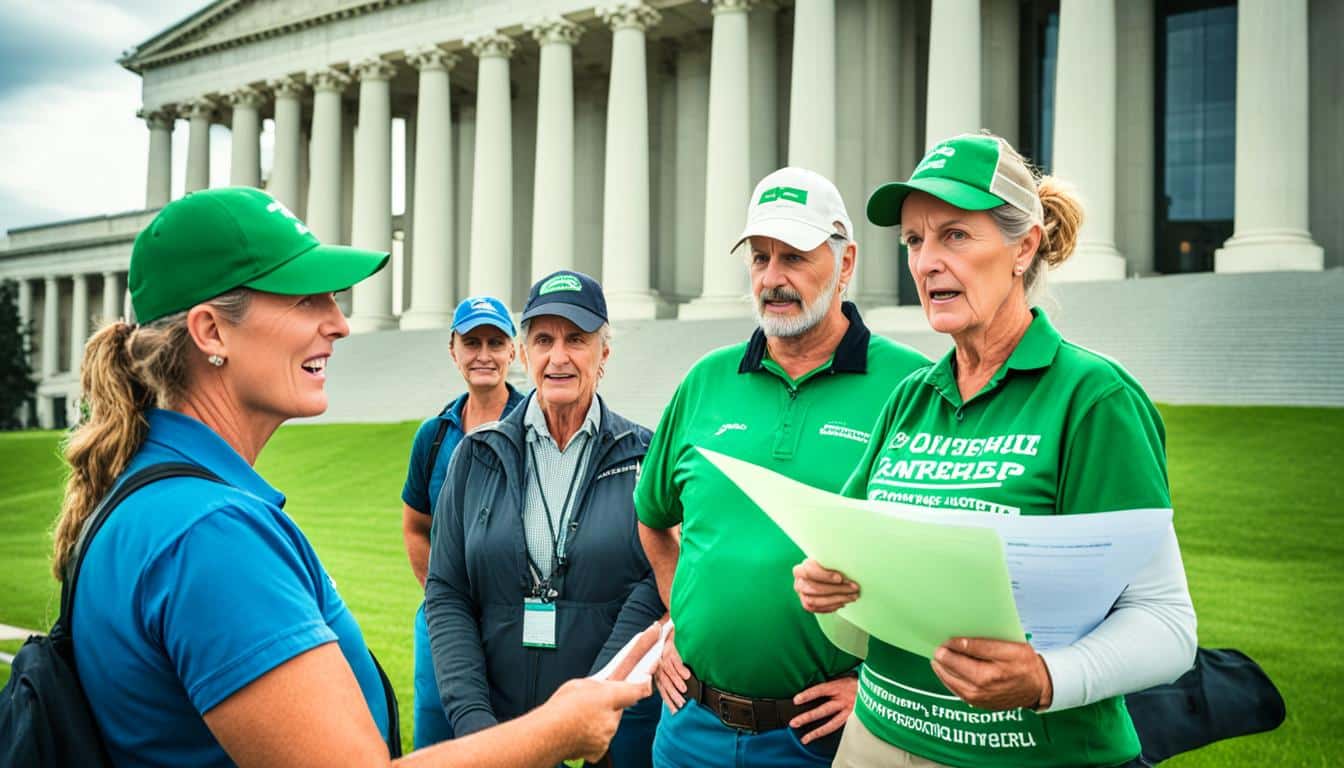
Did you know that agricultural support policies provide over $800 billion worldwide every year? This huge sum shows how vital these policies are on a global scale. In the United States, the Farm Bill is key for the farming sector. It deals with environmental challenges and affects how food, communities, and industries thrive.
The 2018 Farm Bill is the latest guide for the US farming sector. It changes rules on areas like trade, food and nutrition, and how we protect nature. It’s different from older bills because it focuses on always improving to meet new challenges. These US policies are important worldwide, as the US shares its farming support with groups like the WTO and OECD. This sharing brings international attention, showing how crucial US agricultural policies are.
Agricultural policy changes in the US are complex yet vital. They aim to help farming now and in the future. These policies adjust constantly and consider effects worldwide. This makes them crucial and hard to figure out sometimes.
The US Farm Bill is key to the country’s farming policy. Always changing to meet new challenges, the current version is the Agriculture Improvement Act of 2018. This act became active in December 2018 and will be in effect until 2023. It covers many agricultural laws, showing how policies must change to keep the sector strong.
In the past, the Farm Bill was made every five years. Since it began, it has grown and changed to match new issues in farming. With each new bill, like the 2018 Farm Bill, improvements were made on what came before. This helps agriculture keep moving forward.
The 2018 Farm Bill has twelve parts, from crops and nature protection to trade, food help, and rural growth. Over five years, it expects to spend around $428 billion. But, only a small part, less than five billion, goes to “Other” projects. This includes helping local markets and advancing organic farming. The bill also changes existing laws in many areas, showing its wide coverage.
The making of the Farm Bill starts with special Congressional groups. These include the Senate Committee on Agriculture and the House Committee on Agriculture. Making a Farm Bill involves several steps like deciding, agreeing, and starting after the President says yes. Sometimes, parts of the Farm Bill can start working later, after more preparation and learning. Also, some issues like rights for farmers and food safety rules aren’t part of this law.
The Farm Bill is really detailed, showing how policies must grow and change for farming in the US. This effort helps the farming world to grow and improve, in big and small ways.
Agricultural policy changes affect many farmers, especially the smaller ones. We need to look at both the good and the tough parts these changes bring. They shape the farming world in deep and varied ways.
Reforms in agricultural policies boost the help small farmers get. They make it easier to sell their produce and encourage earth-friendly farming. This means they can grow more crops. The changes help small farmers cope better and stay strong against challenges.
But, there are hurdles to face too. Getting used to new rules and coping with market stress isn’t easy. Switching to eco-friendly farming needs both knowledge and money. Also, the changes must avoid issues like harming the environment more.
Policy changes can do a lot for how much we grow and how well we look after the earth. They aim to make farming better for both the economy and nature. For example, they might stop crops prices from spiking because of climate change, benefiting us all.
The European Union’s efforts show that farming can be profitable and good for nature at the same time. Israel’s changes also focus on farming in a way that respects the environment. They do this by cutting taxes and giving farmers money based on how much land they farm, pushing for eco-friendlier methods.
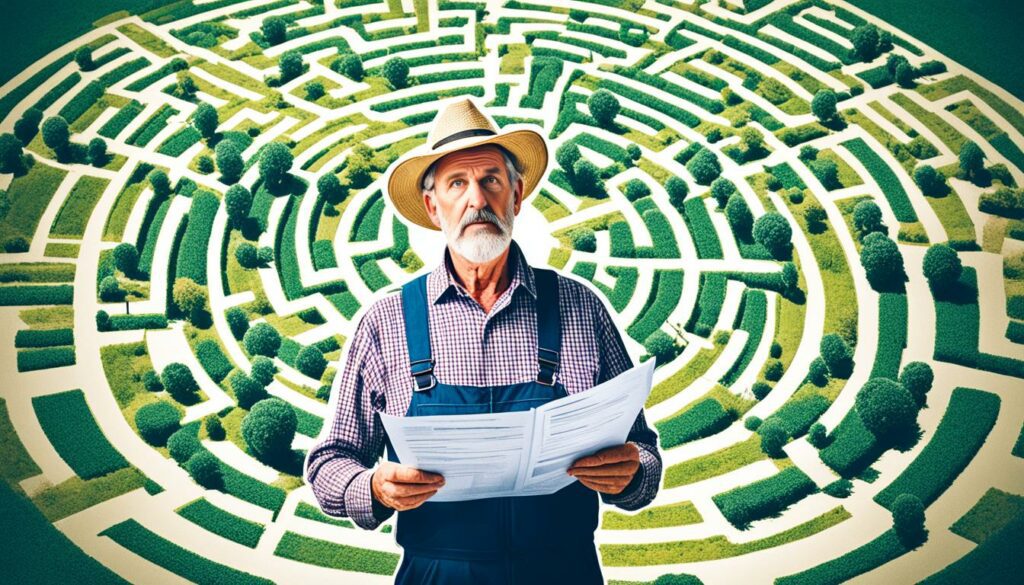
Bringing in green farming methods through policy changes is key. It helps boost crop growth while doing less harm to our planet. By backing small farmers, these changes make sure farming is strong and productive everywhere.
In the US, farming regulations are a mix of rules covering many aspects. These include subsidies for farmers, how they care for the land, protecting crops, and preserving wildlife. The Farm Bill is a key part of these rules, updating every five years to include changes in agriculture like food safety and helping rural areas. The latest version, the Agriculture Improvement Act of 2018, replaced the 2014 bill, making big changes in farming.
The Farm Bill affects many areas of farming, such as how crops are grown, the land’s protection, helping rural areas develop, and feeding people. It tries to balance making food with taking care of the environment and meeting market needs. Not everything in the Farm Bill happens right away. It needs time for new rules to be made and for people to learn about them.
| Policy Area | Key Regulation | Implications |
|---|---|---|
| Commodity Programs | Price Support Mechanisms | Stabilises farmers’ income by managing market volatility |
| Conservation | Environmental Quality Incentives Program | Promotes sustainable farming practices to safeguard natural resources |
| Rural Development | Infrastructure Grants and Loans | Encourages economic growth in rural communities |
| Food and Nutrition | Supplemental Nutrition Assistance Program | Improves food security and nutrition among low-income individuals |
Farming rules are changing to fight new challenges and to be more eco-friendly. There are new plans to help farmers use practices that are good for the planet. Plus, the US shares how it helps its farmers with other countries to learn and make better rules for everyone. This sharing helps make farming better for the economy and the environment.
In the future, farming rules will focus more on dealing with climate change, making sure everyone has enough food, and keeping nature diverse. These new goals aim to make farming in the US strong and do well against future problems.
Making rural areas better involves many actions. Both governments and local people must work together. Often, places in the countryside in poorer countries face poverty and hunger. A mix of help from the government and community work is the key.
This help includes support for farmers from the government and local projects. These efforts make a big difference in these areas.

Governments have a big role in making rural places grow. They give power and money to local leaders to decide things. This makes it easier for governments to help their areas.
GIZ is a big part of this, offering advice and training. It helps make sure places have things like forests and water to use. These actions help rural areas a lot.
Local plans are important in helping the area. They bring new ideas and businesses to the countryside. GIZ helps these plans by supporting local groups. It also helps make sure people have rights to their land.
This leads to better relationships between cities and the countryside. It helps rural places get better services and grow. Digital tools also help bring these services closer.
Thanks to these smart strategies, rural places can become better to live in. They also become more prosperous.
There’s a big push for eco-friendly farming today. The Farm Bill plays a huge role by backing various green schemes. These encourage farmers to be productive without harming nature.
The Farm Bill conservation programs have several key parts. One is the CRP, which takes land out of farming for a while to improve grasslands. Then, there’s the CLEAR-30, a 30-year plan for better water, less erosion, and keeping animal homes safe. Finally, there’s the CSP, offering money to farmers who keep their grasslands healthy.
These green projects are really making a difference. For example, the EQIP has helped farmers do more for the environment on their land. It’s improved how we use water and take care of the soil. This has made farms more efficient and helped nature at the same time.
“Support to producers in reviewed countries ranges from 1% to more than 50% of gross farm receipts, with the United States directing around 80% of total support to individual producers. This balance underscores the importance of environmental conservation initiatives in ensuring sustainable agriculture globally.”
| Country | Producer Support (% of Gross Farm Receipts) |
|---|---|
| United States | 80% |
| Japan, Korea, Switzerland | 50% or above |
| Brazil, Australia | Below 3% |
| OECD Average (2015-17) | 18% |
The 2018 Farm Act shows a big commitment to being green. It dedicates $29.5 billion to green projects over five years, helping farmers use innovative and eco-friendly methods. This makes farms better for the planet and still productive.
The US has cut back on the money it gives to farmers. This affects farmers and the industry. Knowing why cuts happen and how people react helps discuss the issue well.
Many reasons lead to less support for farms. The need to save money and focus on sustainable farming stands out. People also talk about how support can harm fair trade and the planet. This makes them want to change the way they help farmers.
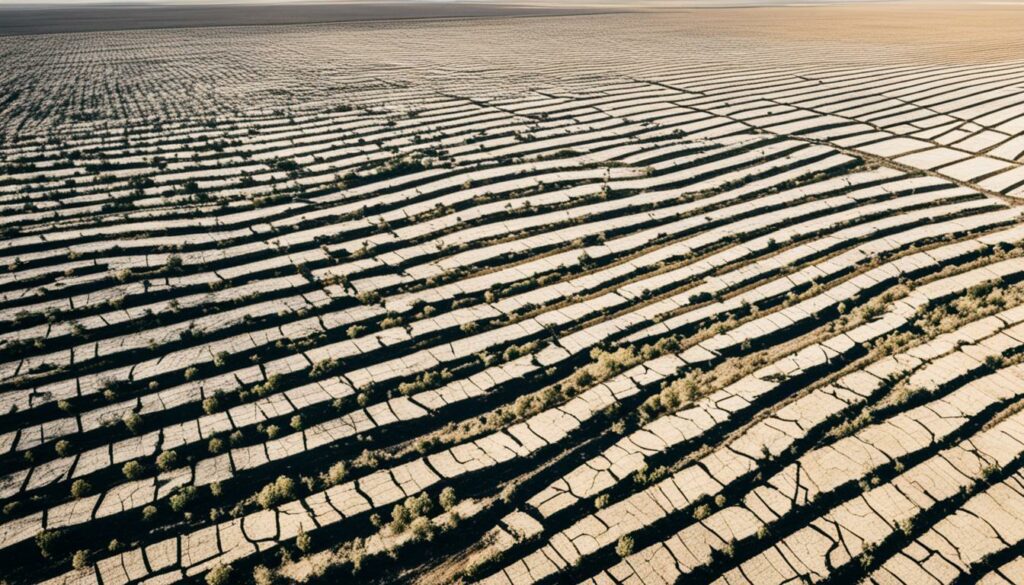
Farmers have different views on the subsidy cuts. Some worry this will hit their income hard. They rely on payments to keep their finances stable. Others say subsidies should help the environment and health more. For example, corn gets a lot of money while environmental-friendly crops get less.
Let’s look at some numbers. Since 1995, corn received over $116 billion in support. However, specialty crops that help the planet get less aid. They only get 17% of what traditional crops do.
Fruthermore, most corn isn’t for people to eat directly. It’s for animal food, making ethanol and additives. This shows the need to change support towards healthier and more planet-friendly crops. This way, farming can meet farmers’ needs better and help the environment and health more.
Agricultural subsidy cuts are a big deal for farmers. We need smart policies that look at money, the earth, and people’s health.
Making sure everyone has enough to eat is a big problem worldwide. Governments work with others to fight hunger. They use many strategies to make food available and affordable. Their goal is to end malnutrition while taking care of the earth.
Big food programs are key to helping people eat well. For example, the USDA helps millions worldwide with $1.6 billion. The McGovern-Dole program feeds more than 16 million poor children. They get better food to grow up healthy.
Also, in countries supported by Feed the Future, over 60,000 people learned better farming methods. This shows how education can make a difference in helping people feed themselves. It’s all about both short and long-term help.
Keeping everyone healthy means making smart plans. The EU has set out goals to better connect farming with health and the environment. There are six main areas they’re focusing on. They want to grow food in ways that are good for people and the planet.
Israel is also doing its part. They’ve made it easier to import fresh food. They’re also putting more into finding better ways to farm. This helps Israel and can teach other places how to become more food secure too.
| Country | Program | Impact |
|---|---|---|
| United States | McGovern-Dole Program | Supported 16 million children |
| Israel | Decision no. 213 | Reduced tariffs, increased R&D investments |
| EU | CAP Reforms | Enhanced environmental and social policies |
Everyone needs to work together for food and health. We must plan for now and the future to eat well and protect our planet.
Good land planning keeps a balance between farming and building. It makes sure we keep our key resources. This is done by following smart rules on how we use our land.
These rules help save the best farming land. They also reduce fights over land use and help towns and the countryside grow together. All this is thanks to working together on plans and laws.
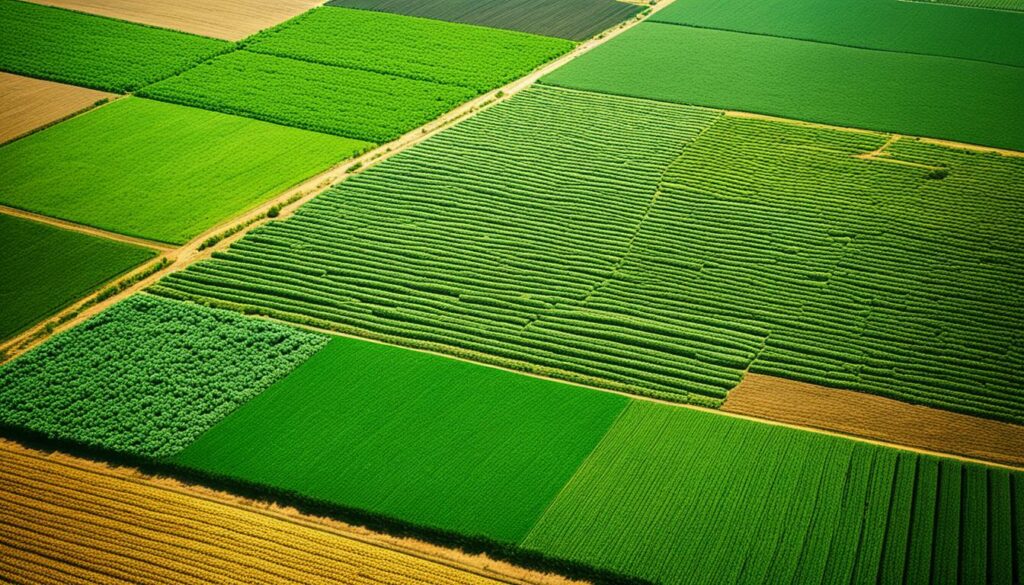
Planned use of land includes rules that save farming land and make farming better for the environment. For example, in Manitoba, how far you put farm animals away from homes changes. It varies from 10 to 1000 meters, depending on how many animals there are.
The same goes for how far you spread manure, which changes based on the way you do it. Often, this is 150 to 800 meters away from homes. All these rules help protect the air and water around farms.
In Manitoba, local leaders make decisions on these rules with help from the state. They also ask for opinions from the public on any changes. This ensures everyone has a say in how their land is used.
It’s important to find the right mix between towns and the countryside. The U.S. lost a lot of farmland from 1982 to 2003, but built on more land. This shows why we need to be careful with planning. It’s to keep farming going and control how cities grow.
In Oregon, there’s a rule called Measure 37 that talks about paying people if land laws affect their property. This has led to big discussions and costs. Plus, more poor families live in central areas of cities now.
So, we have to find the right balance between growing and saving land. This makes sure farming keeps going strong despite more people moving to cities.
To push forward agricultural sustainability, we need policies that support eco-friendly farming. The EU’s Common Agricultural Policy (CAP) 2023-27 is a big step in this area. It offers major funding and guides to change how farming is done.
Financial support is key in encouraging eco-friendly farming. The CAP has set aside €387 billion for the 2021-27 period to help. Of this, €291.1 billion comes from the European Agricultural Guarantee Fund (EAGF), €95.5 billion from the European Agricultural Fund for Rural Development (EAFRD). It also includes €8 billion from Next Generation EU to help rural areas move towards the European Green Deal and digitalization.
The new policy allows EU countries to move up to 25% of their CAP budget between income support and rural development. This change helps them focus on what their farming areas need most. Also, the European Commission is offering €10 billion from the Horizon Europe program for research and innovation in farming, rural areas, and the bioeconomy.
| Policy Element | Description |
|---|---|
| Biodiversity Requirement | 3% of arable land dedicated to biodiversity and non-productive elements, with potential up to 7% through eco-schemes. |
| Eco-schemes Budget | At least 25% of direct payments earmarked for climate- and environment-friendly practices. |
| Income Support Redistribution | At least 10% of direct payments dedicated to redistributive income support for smaller and medium-sized farms. |
| Gender Equality | Increased focus on improving gender equality and participation of women in farming. |
It’s crucial to have long-term policy goals for sustainable farming. These policies aim to offer strong support. They want to improve agricultural sustainability and ensure fair pay for farmers. This tackles issues like market changes and protecting the environment. It helps farms be strong in the face of challenges.
The CAP strives for fair income support in the EU to help both bigger and smaller farms. This move is important for the success of small farms, key for many rural areas. And it helps achieve wider policy goals for better food safety and a healthier environment for all.
Commodity programs and crop insurance are key to a steady, reliable farming sector in the US. They give vital financial help to farmers. These make up the central part of the country’s agricultural policies, which aim to lower risk and promote long-term farming.
The 2018 Farm Bill highlighted some major commodity programs. These include PLC, ARC, and the Marketing Assistance Loan Program. PLC steps in when the prices of goods like wheat, corn, or peanuts drop under what’s expected. For farmers to get this help, they must meet certain income and activity criteria.
ARC comes in two forms: ARC-CO and ARC-IC. They protect against revenue drops either as a county average or individually. They change with the market, thanks to the 2018 Farm Bill. This helps keep farmers economically secure.
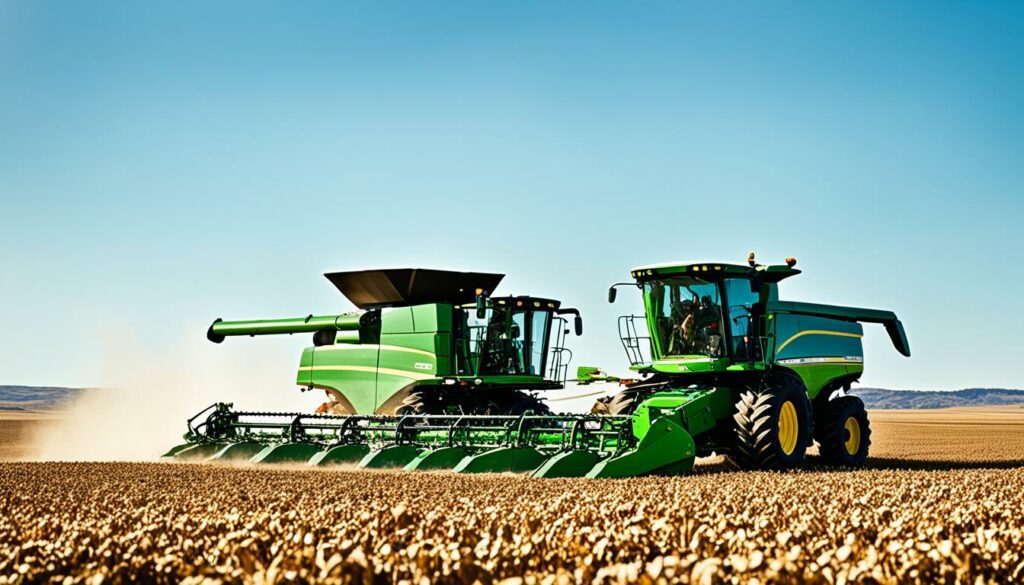
Letting farmers use their goods as loan collateral is what the Marketing Assistance Loan Program does. This boosts financial safety. It means farmers can handle market risks better, keeping them productive and strong.
| Commodity Program | Description | Eligibility | Key Features |
|---|---|---|---|
| Price Loss Coverage (PLC) | Provides payments when the effective price falls below the reference price. | Active farmers within AGI limits. | Effective reference price adjustments; diverse covered commodities. |
| Agriculture Risk Coverage (ARC) | Compensates for revenue losses at county or individual levels. | Active farmers within AGI limits. | ARC-CO and ARC-IC types; variable reference prices. |
| Marketing Assistance Loan Program | Uses eligible commodities as collateral for loans. | Active farmers within AGI limits. | Loan rates established for 2019-2023 crop years; multiple commodities. |
Crop insurance is crucial for farming risk management. Farmers pay a small part of the premium, with a big portion covered by USDA support. The 2018 Farm Bill was a game-changer, now including hemp and over 100 other crops or animal products. This gives farmers wider coverage.
It includes plans like YP and RP for yield and revenue protection. CAT helps for huge yield losses at a base level. Whole Farm RP covers all farm products with a single policy.
Schemes like SCO and STAX add even more protection. SCO offers area-wise coverage with other plans for added safety, while STAX aids cotton farmers especially. It all shows how many options farmers have to keep their farms safe.
These programs and insurance are vital for the US farming sector’s stability. They offer crucial help and risk management in a changing market. With these in place, farmers can ensure their farms keep growing sustainably.
Doing agricultural research and using innovative farming technology is very important. The Common Agricultural Policy (CAP) has a projected €387 billion for 2021-27. This aims to make farming better. The European Agricultural Guarantee Fund (EAGF) will use €291.1 billion. The European Agricultural Fund for Rural Development (EAFRD) gets €95.5 billion, which has €8 billion from Next Generation EU.
CAP lets EU countries change up to 25% of their funds for different uses. This makes it easier to put money where it’s most needed. It helps in investing a lot in agricultural research and new innovative farming technology.
The Horizon Europe programme also plans to give €10 billion for agriculture and rural development. This money will help use better farming methods. It will also support new farming technologies.
Let’s look at how these changes and money have helped:
| Funding Component | Allocation (in € billion) |
|---|---|
| CAP (2021-27) | €387 |
| EAGF | €291.1 |
| EAFRD | €95.5 |
| Horizon Europe Programme | €10 |
This money is key to dealing with more demand on Europe’s farms. This demand comes from more people and more money to spend. Also, there has been a 35% drop in the sale of veterinary antimicrobials. This is from 2011 to 2018, showing the good effects of these farming improvements.
The government is key in changing agriculture. It does this through policies, rules, and money help. This influence changes how farm work is done, making it better and greener.
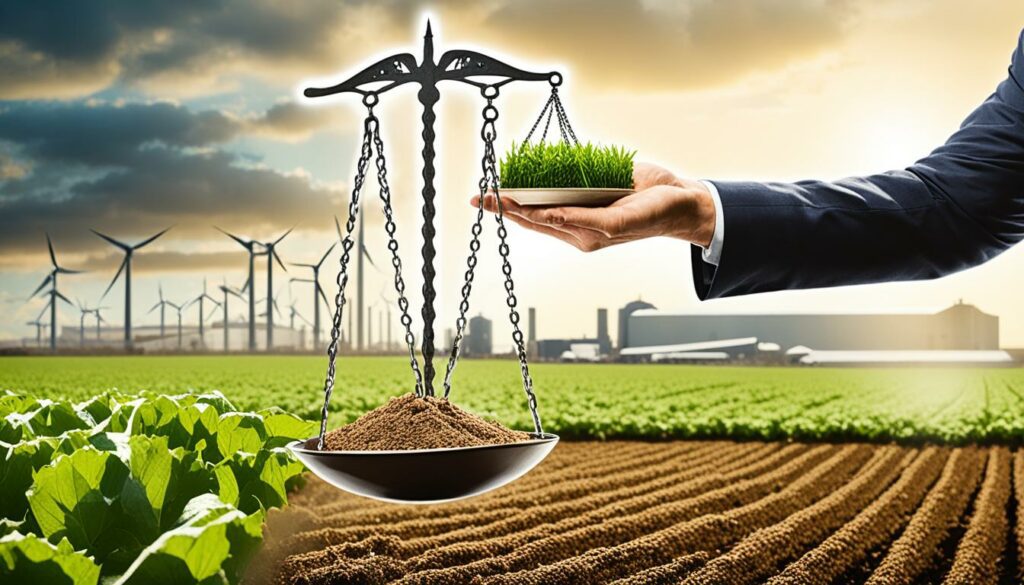
Looking at federal and state policies helps us see how farm changes happen. The US Farm Bill shows us what both levels look at. It helps farmers with money, tax breaks, and more.
States also have their own rules. They might do things differently from the federal level, based on local needs. This mix of rules shows how farming policies always change, trying to do what’s best for everyone.
Lobbying plays a big role in making farm changes. Big or small, groups can talk to lawmakers to push for some rules over others. This affects what farming policies focus on, like less money for crops or more for new green ideas.
Political will is also very important. It changes with what the public wants and what studies say. The decision on how to spend money on farming every year is huge. It can impact things like global warming. In the US, a choice on biofuels showed us how wrong moves can hurt the environment. In India, changes in selling farm goods met hard resistance from small farmers, showing why governments might change their minds.
| Assessment Area | Number of Studies |
|---|---|
| Impact on Agricultural Production | 54 |
| Land Allocation and Crop Diversification | 25 |
| Efficiency Improvements | 23 |
| Employment Rates | 18 |
| Impact on Farm Income | 17 |
In the end, it’s clear government rules change how farms work. Lobbying and what people want to see in farming play big parts. Knowing this helps predict what’s next for farming.
The US has a big impact on agriculture worldwide. Its policies shape trade and food security globally. By making strong trade deals and forming key partnerships, the US leads the way in global agriculture.
The US leads in selling farm products worldwide. This shows how US policies shape global trade. Deals like the USMCA and partnerships with Europe and Asia are key for fair trade and stable markets.
US trade policies affect everything from farm earnings to meeting international rules. For example, new climate-focused programs show the US is serious about fighting climate change and staying competitive globally.
US farm policies help keep the world fed. During the COVID-19 pandemic, the US made sure food kept flowing by acting quickly and helping at home. This also helped people around the world.
Lowering global farm policy problems could bring $56 billion in yearly benefits. The US could gain $13.3 billion annually from this. It highlights how global trade can benefit everyone when policies are well-matched.
US efforts to make farming fairer and greener are important too. Upgrading organic rules and supporting eco-friendly farming set a good example for others. This is about keeping farms productive and in balance with nature.
| Category | Impact |
|---|---|
| Export Volume | Largest in world, double any other US industry |
| Global Welfare Gains | $56 billion per annum |
| US Welfare Gains | $13.3 billion annually |
| Policy Distortion Contribution | 16% of global distortions |
US agricultural policies, when aligned with global norms, make international trade run better. They also boost food safety around the world. By working on fairness and green farming, the US helps all nations build stronger and more sustainable food systems.
We need to look closely at how well agricultural policy reforms are working. This means checking if they make farms more productive, if they help the environment, and if they make enough money. It is tricky because we need both numbers and stories to really understand the changes.

To see if agricultural policies are doing well, we look at key things:
Take the Common Agricultural Policy (CAP), for example. It’s a big plan with €387 billion to spend from 2021 to 2027. A lot of this money goes to helping European farmers and making sure they help the environment.
The CAP also tries to make sure smaller farms get some help. It makes eco-friendly farming more important by putting 25% of the funding into it. This is good for the climate and nature.
Even with these plans, there are still hurdles to jump. Making policy changes work can be hard. Some things that make it tough are:
To face these challenges, everyone needs to be involved. New CAP rules now need farmers to really work on their land to get paid. And they’re adding more for young farmers and making sure there’s equality for all in farming. This helps with growing in the right ways for everyone.
In the end, figuring out if policies are working is key. But making them work in real life needs smart thinking and everyone working together. It’s a journey that needs everyone on board.
In wrapping up, we’ve seen that the US needs a unified strategy for agriculture. It’s not just about the economy; we must consider social and environmental effects too. The Food and Agriculture Organization and similar groups are helping with this through tailored plans for better farming and food security.
For the future, the US should have a strategy that can change and improve over time. Stronger talks between leaders, experts, and analysts are vital for smart decisions. Bringing everyone into the discussion on these policies makes them more useful and ensures they work well.
Also, fixing global agricultural policies could boost the economy by $56 billion yearly, with $13.3 billion for the US. These changes would lead to fairer prices and help emerging countries. If the US leads with a strong, unified farming strategy, it can bring about a flourishing and fair agricultural world.
Enhancing farming sustainability is a big goal. This involves improving yields and helping small farmers. Also, it aims at ensuring there’s enough food and growing rural areas.
The Farm Bill has evolved a lot since it started. It now covers new issues like conservation, trade, and food safety. Each new Bill changes and updates the old rules.
The Bill covers crop, conservation, and research programs. It also includes nutrition support and trade. Plus, it looks at organic farming and rural development.
Reforms can be good for small farmers. They offer better market access and support sustainable ways. Yet, new rules and market changes might bring difficulties.
Today’s regulations cover many aspects of farming. They include rules on how to farm, help like subsidies, and how to protect the environment. These rules affect how much is produced, how markets work, and our environment.
There are government strategies and programmes for help. These offer things like credit, managing risks, and local plans for improving business and ideas.
The Farm Bill supports ways to protect nature. Programs encourage using land and water well, to keep the environment healthy while farming.
Sometimes, subsidies are cut because of money issues or changing goals. There’s talk about how they affect trade and markets, too. More focus is now on subsidies that help the environment and health.
Food policies help make sure everyone has enough and good food. They help needy people and make our food system stronger.
Planning land use well is key. It keeps food growing and cities growing too. This means saving the best land, farming wisely, and solving land use problems.
Policies push for farming that lasts a long time. They encourage good farming methods and using the land and technology wisely.
Crop insurance helps farmers manage risks. It protects against bad weather and market changes. It’s an important part of farm support.
The US supports new ideas and research in farming. It offers money through grants and support, to make farming more productive and eco-friendly.
The government leads in changing farming rules and policies. It listens to people, studies the facts, and makes decisions at all levels.
US farming choices affect food safety worldwide. Through trade and partnerships, it helps set global farming rules. It’s key for fair and lasting food systems.
We look at how much is grown, how long it lasts, and the economy. These help see if new policies are working and show what still needs fixing.